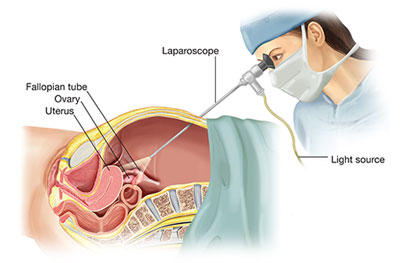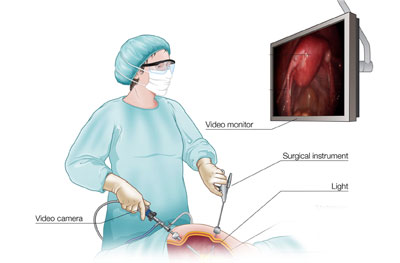
Laparoscopy is a minimally invasive procedure that allows a doctor to perform surgical procedures using only a small incision. It enables quick recovery of the patient, and most people get back to work within a week. It is also called Minimally Invasive Surgery (MIS), Band-aid surgery or Keyhole surgery.
During Laparoscopy, a small incision is made in the abdomen or pelvic region to insert an instrument called Laparoscope, which enables the doctor to take a look inside the abdomen. It is used to detect Cysts, adhesions, fibroids and infections in the organs.
Advantages of Laparoscopy
Doctors generally recommended Laparoscopy because of the following reasons:
- It is relatively simple, safe and poses lower risk, compared to alternative procedures.
- Takes less time and causes less injury to delicate tissues than traditional methods.
- It is generally an outpatient procedure that doesn’t call for a hospital stay.
- It allows speedy recovery.
- It is less expensive than open surgical procedures.
What can Laparoscopy be used for?

Laparoscopy is done either for accurate diagnosis or for surgical treatment.
As a diagnostic procedure, it allows doctors to determine the cause of abdominal or pelvic pain and helps them to recommend an appropriate therapy. It can be used diagnose:
- Cyst – A closed sac with liquid or semisolid material.
- Soft – tissue tumor – A mass resulting from uncontrolled growth of cells, either benign or cancerous, which can occur at various locations in the abdomen.
- Fibroids – A benign overgrowth of uterine muscle attached to the uterus.
- Adhesion – Fibrous tissue abnormally uniting internal organs.
Laparoscopy can also help determine the cause of pain in case of:
- Endometriosis – the presence of tissue, like endometrium, outside the uterus.
- Pelvic inflammatory disease – an infection causing information of the uterus, fallopian n tubes, ovaries or peritoneum.
- An ectopic or tubal pregnancy – pregnancy in which the fertilized egg begins to grow outside the womb.
Recovery
For the first two or three days following Laparoscopy, most women are tired and groggy. You may have to restrict driving for two weeks following Laparoscopy. Intercourse, tube bathing, douching, and swimming will also be restricted. You will probably be very tired and need a lot of sleep. However, be sure to get up and move around as and when you are able to. You will recover quicker if you move about.
Physical signs to watch out for post Laparoscopy
- Fever and chills
- Abdominal distension
- Vomiting
- Difficulty urinating
- Sharp and unusual pain in the abdomen or bowel
- Redness at the incision site, which can indicate infection
- Discharge from any place where tubes were inserted or incisions were made
